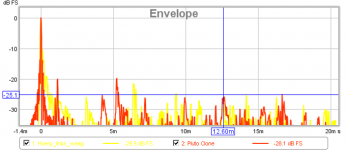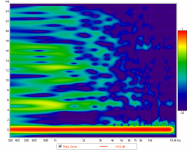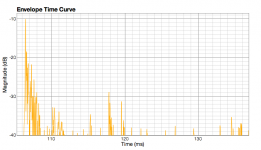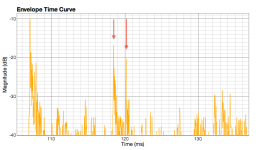My speakers are even "wider" if we look at 360° and not 180° only. So my reflections have a harder time to cancel one another in the L-R measurement.
Rudolf
And that increased power into the room that the OB has towards the back results in almost no difference in the DR ratio in the high frequencies (if I'm reading your last graph correctly). This means your system is more diffuse (lower clarity) compared to say, horns.
Didn't you claim that for your speakers for an extended area?
I don't think so. I always thought this was a silly goal. Why do we care about other positions if they are never going to be occupied? Unless it's a home theatre, all I care about is the listening position. I don't want directivity because the sound is better everywhere; I want it because it's better in the sweet spot.
In my part of the world Controlled Directivity would be a directivity that is free from jumps at the crossover frequencies and in general rising with frequency.
If such controlled directivity is achieved, I would look at the room first. Depending on the room situation (and what I'm allowed to change/improve or not) I would decide whether I need completely constant directivity or if rising directivity alone would suit the situation better.
Rudolf
I agree with Rudolf here, not dewardh. It does not have to be constant directivity. In fact, putting that much power into the room in the HF will mean a lot of absorption is needed to make it less bright.
Increasing directivity is ok, but peaks in power response, such as woofer crossing to tweeter on bare baffle where the tweeter is acoustically small, are not. There is a coloration there that you can perceive when you have removed it.
Means no such thing. With constant directivity both on-axis and power response are addressed in the same manner . . . by equalization. If the sound of the speaker in the room is "too bright" then simply reduce the treble . . . with constant directivity balance is maintained throughout the room. Because of the way rooms commonly reflect (particularly at the wall-ceiling boundary) it is sometimes advantageous to roll off the rear radiation more in the top couple octaves . . . it's a room-specific choice.It does not have to be constant directivity. In fact, putting that much power into the room in the HF will mean a lot of absorption is needed to make it less bright.
Of course if you listen in only one (single seat) position you can get away with a lot of otherwise unsatisfactory things. It's a situation which I never experience, since I design for an extended "listening area" and "good" sound throughout the room.
I have come to believe that the first, and essential, step in designing a quality speaker is to define the polar response . . . it is the foundation of everything, and it must be uniform. If it is wrong your speaker will be like a house built on sand. After the polar is established frequency response and crossover can be addressed . . . without the complication of dealing with different on-axis and power response in the room. Then you can address distortion . . . usually a matter of driver selection. While it is always a recursive process it must start with the desired polar, and the baffle which will produce it, since that is fundamental to a good design, and if wrong it cannot be "fixed" in any other way.
Just saying polar response is the most important is not enough. There are subtle distinctions. First of all, a rolled off treble in the on-axis response sounds like a rolled off treble, even if you have constant directivity. I have tried it a number of times. Second, the notion that if you are listening in the sweet spot, the on-axis response is all that matters is flawed. I don't think it is so, and I don't believe most people in this thread do either.
Off-axis response must be smooth, and replicate the on-axis response. Narrowing in the treble is okay. But bloom is not good anywhere.
The correct way, as I have experienced, is to have flat on-axis and either narrowing off-axis in the treble, or if you have constant directivity, a more absorptive room. Again, this comes to the notion that any particular directivity is not necessarily preferred. We know that flat power sounds bad. Beyond that, it is the combination of directivity and the room that determines the perceived balance. This was the major conclusion of that giant directivity thread.
In this thread, we have been going beyond what we know so far, exploring whether directivity in the lower octaves can improve localization.
Off-axis response must be smooth, and replicate the on-axis response. Narrowing in the treble is okay. But bloom is not good anywhere.
The correct way, as I have experienced, is to have flat on-axis and either narrowing off-axis in the treble, or if you have constant directivity, a more absorptive room. Again, this comes to the notion that any particular directivity is not necessarily preferred. We know that flat power sounds bad. Beyond that, it is the combination of directivity and the room that determines the perceived balance. This was the major conclusion of that giant directivity thread.
In this thread, we have been going beyond what we know so far, exploring whether directivity in the lower octaves can improve localization.
Who said that? I said it's the foundation, and the first step in design . . . if you don't have it right your speaker will suck regardless what else you do.Just saying polar response is the most important is not enough.
But there certainly are a lot of other ways to make a speaker suck even if the polar is good . . .
I have very limited knowledge of speaker design, but I am learning....
but with what I do know, I can agree that having a uniform polar response is the most important. I say this because not everyone can sit in the sweet spot and I would much rather have a good room filling sound than one that only sounds good in a small window.
That said, I do think it is very room dependent on what frequency range one must focus on keeping a good polar response. I can understand why some say it doesnt matter below 700hz. However, when I move off axis now I hear a considerable amount of "boominess" that I wish wasnt there.
but with what I do know, I can agree that having a uniform polar response is the most important. I say this because not everyone can sit in the sweet spot and I would much rather have a good room filling sound than one that only sounds good in a small window.
That said, I do think it is very room dependent on what frequency range one must focus on keeping a good polar response. I can understand why some say it doesnt matter below 700hz. However, when I move off axis now I hear a considerable amount of "boominess" that I wish wasnt there.
This isn't baseball. You don't get to second from first. You have to start with a design that permits both.Toole's research says it starts with flat and smooth on-axis response. Second in importance is off-axis response.
"Flat and smooth on-axis response" may well be the top criteria for "listener satisfaction", but it is well down the road in design . . . by the time you are working on equalization you should have decided on a desired polar, maximum SPL (which will determine driver size), number of drivers, separate subwoofer (or not) and, of course, the size of the "listening area" and the room the speaker is to be used in. Among a raft of other things.
Once those other things are sorted out getting flat-on-axis is relatively easy, and off-axis just falls into place (if you have a uniform polar). But what is important in the end product gives limited guidance how to get there and, as already noted, it is an iterative process . . . a choice further into the process may force a backtrack on a previous design decision. Restrictions not related to sound, like acceptable size (a constant directivity horn loudspeaker is quite possible if there is no size constraint, or if corners are available) and budget (the cost of bass drivers tends to "high" in dipole designs) may force essential compromises. But if you start the process without constant directivity you will never get it (and you'll never get both first and second, let alone get past them to the other important "listener satisfaction" features).
Last edited:
Don't know what the amplitude difference is in the shading, but at least with the Fender at 55 Hz, there isn't much at all above about 850 Hz - that is still above 700 Hz though. BUT the output above perhaps 600 Hz or so may not be significant. Don't know. __________________
Significance
The higher harmonic components contribute to timbre, attack and localization. Instrument like bass guitar, if it doesn't have zing or buzz, will sound dull, won't get attention. This is related to attack which is the sound right at start of note which identifies to folk what instrument they're hearing. For this instrument defining the start of the note is really important because it establishes hearing rhythmic precision. Also it aids localization, as we've been discussing.
Significance
The higher harmonic components contribute to timbre, attack and localization. Instrument like bass guitar, if it doesn't have zing or buzz, will sound dull, won't get attention. This is related to attack which is the sound right at start of note which identifies to folk what instrument they're hearing. For this instrument defining the start of the note is really important because it establishes hearing rhythmic precision. Also it aids localization, as we've been discussing.
Yup.
I'm almost positive though that with something like "slap" bass that you'll see higher freq. bandwidth and amplitudes on a spectrograph.
Note though that the larger portion of music with that driving 40-50 Hz bass-line isn't being played as "slap" bass (or another type of stronger attack emphasis style), it's more of that plummy thumb-picked sound. In a live event though you can still hear where it (bass amplifier stack) is quite easily *unless* you are too far away (..when producing that sort of plummy bass line). (..personal experience on Austin's 14th street establishments..
bass
Hi there S: Last time I was at at concert, the bass players were bowing the strings, rather than slapping at them, although some pizzicato technique was utilised. Also, I'm curious about the need to request a seat at a concert (or jazz club performance) in the "sweet spot". Most often, we listen to recorded music at home, negating "head in vice seating sweet spot". ...Michael
Yup.
I'm almost positive though that with something like "slap" bass that you'll see higher freq. bandwidth and amplitudes on a spectrograph.
Note though that the larger portion of music with that driving 40-50 Hz bass-line isn't being played as "slap" bass (or another type of stronger attack emphasis style), it's more of that plummy thumb-picked sound. In a live event though you can still hear where it (bass amplifier stack) is quite easily *unless* you are too far away (..when producing that sort of plummy bass line). (..personal experience on Austin's 14th street establishments..)
Hi there S: Last time I was at at concert, the bass players were bowing the strings, rather than slapping at them, although some pizzicato technique was utilised. Also, I'm curious about the need to request a seat at a concert (or jazz club performance) in the "sweet spot". Most often, we listen to recorded music at home, negating "head in vice seating sweet spot". ...Michael
Hi there S: Last time I was at at concert, the bass players were bowing the strings, rather than slapping at them, although some pizzicato technique was utilised.
Also, I'm curious about the need to request a seat at a concert (or jazz club performance) in the "sweet spot". Most often, we listen to recorded music at home, negating "head in vice seating sweet spot". ...Michael
"Slap" bass is in reference to a bass guitar.
There are also other bass instruments shown on that same site (scrolling down further):
Audio Spectroscopy in the Analysis of Stringed Instruments and Their Components
I'm assuming the upright bass was plucked in the example, as opposed to being bowed. (..but I didn't find anything suggesting either.)
The "sweet spot" for a live performance (Acoustics) is relative to the performance, the venue, and listener's taste. Most of the time it's about the ratio of direct to reflected sound (it angle, intensity, and time for reflections) - or getting the sense of "envelopment" just right while being able to distinguish each source of sound. The classic "sweet spot" is a mid-hall perspective.
This is very different than the "sweet spot" for stereo reproduction - which has limitations on listening distance from both loudspeakers based on intensity. (..channel balance and stereo loudspeaker pair directivity.)
I consider the contra-lateral reflection to be a lessor problem that the direct one - it is more delayed, lower level and not a coherent signal.
I was doing some experiments with increased speaker toe-in. At 56° I get a pretty spacious presentation. The ETC shows two strong contralateral reflections after about 11ms and 13ms:
When putting thick porous absorption next to the speaker, the reflections are gone:
Now the image is more detailed and localization is improved but all spaciousness and depth is gone.
In earlier tests I didn't get the spacious image with a 45° toe-in. My assumption was that a contralateral reflection couldn't contribute to spaciousness. It probably simply had to pass a certain level to become a contributor to perceived spaciousness.
Attachments
Markus,
The spaciousness that is "gone" is the spaciousness of your listening room as a sound effect. This is not a spacious image rendered in source recording.
Without absorber in place the reflections at 11ms and 13ms are only -7dB and -10dB relative to direct sound; with absorber these are reduced to -19dB and -21dB. Switching between the two absorption conditions A/B in short interval would be easy to perceive reflection effect as being On/Off.
Even with reflection reduced to -20dB of direct sound, masking of recorded reverberant effects that are -20dB to virtual source and 12ms later happens.
Then there is matter of spectral content of reflected sound. From description of toe in and directivity of speaker in use, the sound projected toward contralateral wall has greater high frequency content than the sound projected directly toward listener. This could serve to enhance the perception of room as a spaciousness effect.
For comparison here is ETC of my Pluto Clone in overlay with ETC from IR posted by Rudolf:

In above plot for Pluto shows floor and ceiling reflections at 4ms, 5ms. Out beyond this in time reflections remain more than 25dB below direct sound for both Pluto in my room, and for Rudolf's result.
My listening room is living room with carpeted floor, acoustic ceiling tiled on plaster. Walls roughly divide up between glass, brick, and wood. Even with lively walls room does not add reflection effect demonstrated with your speakers. Imaging detail is super. Relatively weak reverberant sounds in recordings come through consistently, building up in perception, supporting space about virtual sources in phantom image.
When I revise speaker alignment substantially, first perceptions are often that sound is 'wrong'. Sometimes, over course of listening for several minutes 'wrongness' subsides and listening becomes relaxed. When alignment is dialed in, relaxed acceptance of perception is immediate, this is when speakers and room vanish.
Here is spectrogram of Pluto:

Windowing is 3ms. Spectrogram reveals very omni behavior <3kHz, and that energy >3kHz is more rapidly absorbed and diffused.
The spaciousness that is "gone" is the spaciousness of your listening room as a sound effect. This is not a spacious image rendered in source recording.
Without absorber in place the reflections at 11ms and 13ms are only -7dB and -10dB relative to direct sound; with absorber these are reduced to -19dB and -21dB. Switching between the two absorption conditions A/B in short interval would be easy to perceive reflection effect as being On/Off.
Even with reflection reduced to -20dB of direct sound, masking of recorded reverberant effects that are -20dB to virtual source and 12ms later happens.
Then there is matter of spectral content of reflected sound. From description of toe in and directivity of speaker in use, the sound projected toward contralateral wall has greater high frequency content than the sound projected directly toward listener. This could serve to enhance the perception of room as a spaciousness effect.
For comparison here is ETC of my Pluto Clone in overlay with ETC from IR posted by Rudolf:

In above plot for Pluto shows floor and ceiling reflections at 4ms, 5ms. Out beyond this in time reflections remain more than 25dB below direct sound for both Pluto in my room, and for Rudolf's result.
My listening room is living room with carpeted floor, acoustic ceiling tiled on plaster. Walls roughly divide up between glass, brick, and wood. Even with lively walls room does not add reflection effect demonstrated with your speakers. Imaging detail is super. Relatively weak reverberant sounds in recordings come through consistently, building up in perception, supporting space about virtual sources in phantom image.
When I revise speaker alignment substantially, first perceptions are often that sound is 'wrong'. Sometimes, over course of listening for several minutes 'wrongness' subsides and listening becomes relaxed. When alignment is dialed in, relaxed acceptance of perception is immediate, this is when speakers and room vanish.
Here is spectrogram of Pluto:

Windowing is 3ms. Spectrogram reveals very omni behavior <3kHz, and that energy >3kHz is more rapidly absorbed and diffused.
Last edited:
It is really difficult to refute association of data with descriptive perceptions. For a working environment, I prefer a room that will allow for detection of system deficiencies. For enjoyment, if I can feel the emotion (or lack of) in the performance for all sorts of music, then it is fine.
It's a big block of Basotect. I just put it right next to my Geddes Nathan's.
Hi Markus,
Thank you for your interesting post. I am somewhat confused here, so please bear with me.
Your measurement results indicate, that even when using Gedde's Nathans, you are still getting lateral reflection at -7dB level. Only after placing additional absorbers, you managed to knock the reflections down to -20dB region.
Is this the correct interpretations of your post?.
Best Regards,
Bohdan
An interesting quote I found last night reading Beyer's "sound of our times"..
"Avery Fisher is less reverberant than Boston Symphony Hall , the tone is very different from the warm, rich ,reverberant sound of Sabine's hall ,being clear, precise and cool so unlike 19th century halls it tends rather to reveal than to flatter. In fact ,Avery is typical of Modern America hi fi concert halls"
and obviously this is for the same type of music played.. I don't think this is irrelevant stuff for us.
"Avery Fisher is less reverberant than Boston Symphony Hall , the tone is very different from the warm, rich ,reverberant sound of Sabine's hall ,being clear, precise and cool so unlike 19th century halls it tends rather to reveal than to flatter. In fact ,Avery is typical of Modern America hi fi concert halls"
and obviously this is for the same type of music played.. I don't think this is irrelevant stuff for us.
- Home
- Loudspeakers
- Multi-Way
- Linkwitz Orions beaten by Behringer.... what!!?

